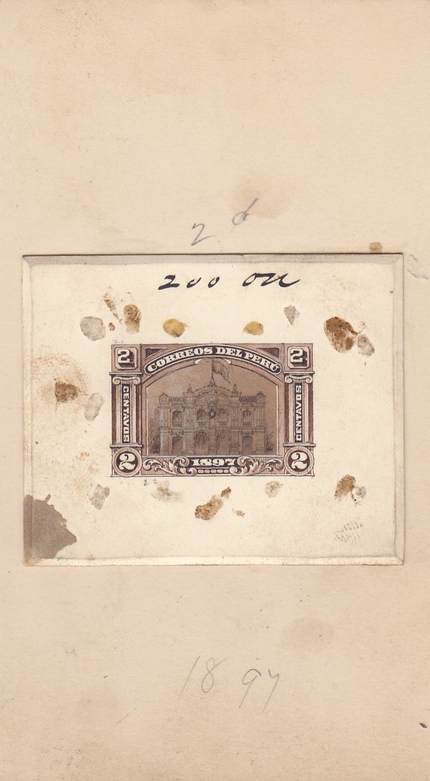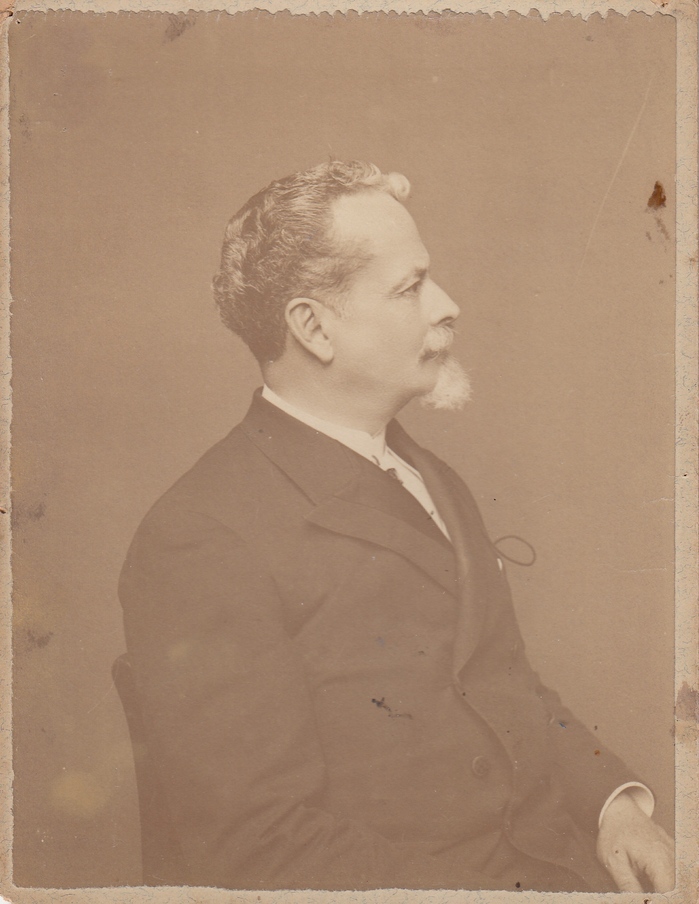
Before a stamp is printed, indeed before proofs are created, a stamp must be designed and ideas proposed. Source material must be acquired upon which a design is to be based and then transformed into a miniature size.
The source material forms the Production File until it is ultimately archived. If the source material has been kept together it can offer a unique insight into how a stamp or series of stamps evolves. When available, source material will often act as the cornerstone of a traditional philatelic exhibit.
The unique items below, originally from the ABNC archive, give an insight into this process…including a proof that would have caused an international incident, had the stamp ever gone to print…
The Central Post Office – La Casa de Correos y Telégrafos – in Lima, Peru, was conceptualized as part of a broader initiative to modernize the nation’s infrastructure during the late 19th century. The project emerged under the administration of President Nicolás de Piérola, who prioritized state-building efforts, particularly in communications and transportation.
The idea for a centralized postal hub in Lima took root as the government recognized the growing need for a more efficient postal system to serve both national and international correspondence.
The decision to construct the Central Post Office was heavily influenced by the increasing demands of urbanization and commerce in Lima. It was located strategically near the Government Palace and the Plaza Mayor, highlighting its importance in public life. The project was also driven by Peru’s entry into the Universal Postal Union in 1879, necessitating upgrades to comply with international standards.
Such a noteworthy project was to be marked by a commemorative stamp to celebrate its inauguration and Don Camilo Carrillo, the then Director of the General Post Office, decided to have three stamps issued to celebrate the occasion.
Events moved quickly. A resolution was issued on February 12th 1897, the American Bank Note Company were appointed and on the 15th March an internal request for engraved proofs was raised.

Three values were proposed, the first being a 1 centavo in ultramarine and depicting a view of a bridge over the Paucartambo river.

This large format photograph was used to create the image for the central vignette. Although the final image on the stamp is true to the photo, much of the detail is lost when reduced to miniature.
An artist then delicately hand paints the proposed frame before dropping in a scaled down image of the bridge.

This sunken die proof shows the finished stamp in the issued colour. The large format index cards that formed part of ABNC’s record keeping system were filed in March; clearly they worked quickly.

The second value was to be a 2 centavos stamp, printed in brown.
Rather than a photograph, this time it appears that the designer was reliant on drawings provided by the Peruvian authorities. The archive contains a large print of the proposed façade, although if you look closely there are multiple differences between this (earlier?) design and the finished building. Noticeably missing is the very grand statuary atop the building.

A later iteration of a pen and ink drawing is much closer to the final design. Note that the flagpole has had to be reduced substantially in order to accommodate it on the stamp!

The finished vignette is then dropped in to the painted frame.


The final stamp in the series is a 5 centavos value printed in rose. Here’s where it gets interesting.
The design was proposed to feature the bust of Nicolás de Piérola, Peru’s then President. Included in the archive is a photograph of the President supplied by the Peruvian Post Office for the ABNC engraver to copy.

However, when designing the stamp, the artist overlaid an engraved image of the wrong President – President Bernado Soto Alfaro of Costa Rica! No doubt the error got spotted in the proofing process and Soto Alfaro was ignominiously defaced. A stamp that would certainly have caused a diplomatic incident, had it ever gone to print.

Costa Rican collectors may recognise the image of Soto Alfaro from the postal-fiscal stamp of 1888 (Scott AR3).
In the end, the correct President was returned to his rightful place, the head being reversed from the photo for the final stamp. Confusingly, the proofs were originally requested in carmine, described in the index by ABNC as light carmine and described in the catalogues as rose, bright rose and rose-carmine. Oh, for consistency!

Ultimately, 1,000,000 copies of each stamp were printed in the US and had arrived in Peru by May. On the last day of the year in 1897, the new Post Office building was finally inaugurated and the stamps placed on sale.

It’s a great article. I really enjoyed it.
Great Work!, congrats!
A couple of corrections. The original order was for plates of 200 images, but was ultimately changed to a plate of 100 images. The final print quantity was 1,000,000 copies of each denomination, not 100,000. The stamps were shipped to Panama on the S.S. Allianca on May 8, 1897 and ultimately to Peru on a Pacific Steamship Company ship. I can furnish a photograph of the ABNC order book page, which shows these details.
Appreciate the additional information Chuck. The last chapter in philately is never written…
Very interesting article, thanks!
Well done !! Costa Rica should be very grateful for this post
Thanks for the nice article. Is the material still in the ABNC archive or is it in a private collection?
The ABNC archive was mostly dispersed in the early 1990’s. This material is currently in my collection, although I may sell it next year.